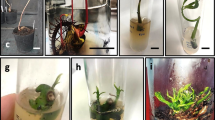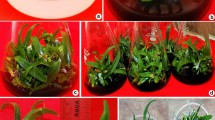Abstract
The fruit of Garcinia pedunculata is one of the costliest indigenous fruits sold in local markets of Manipur for cuisine and various other utilities. Its population seemed to decline due to overexploitation, habitat loss, and the absence of cultivation or propagation methods. Hence, studies on the regeneration aspects of the species in ex-situ and in-vitro conditions were performed. Mean germination of 79–93% was achieved within ca. 3 weeks when dormancy imparting rind of the arillate seed was removed. About 76% of seedlings may survive if arilled seeds are scarified in their in-situ conditions. Removal of testa doesn’t affect germination; in fact, it increased the viability of the seeds. Pre-harvesting of immature fruits devoid of set seeds, physical dormancy imparted by seed rind, and loss of natural dormancy breaking mechanisms are some of the factors which limit the natural propagation of the species. Two types of seedling patterns, i.e., normal-type and adventitious embryonic-type were observed. Our finding indicated that resource allocation affects the level of adventitious embryony as evidenced by ca. 90% of multiple seedlings in in-vitro treatment. On the other hand, adventitious embryony seemed to have a negative effect on the embryo mass and growth due to resource diversification to the number of adventitious shootlets. Besides morphological similarity, ISSR profile of uniform pattern among adventitious shootlets and mother plant genetically confirmed adventitious embryony resulting from apomixis. This adventitious embryony and adventitious shoot micropropagation can be exploited for restoration and large-scale propagation of selected genotypes.
Key message
Micropropagation of Garcinia pedunculata through its adventitious embryony was established for large-scale propagation of selected genotypes.




Similar content being viewed by others
Data availability
We declare that data from the experimental work and findings are available.
Abbreviations
- DGS:
-
Daily germination speed
- LDG:
-
Last day of germination
- FDG:
-
First day of germination
- MCB:
-
Moistened cotton bed
- GE:
-
Germination energy
- MDG:
-
Mean daily germination
- GV:
-
Germination value
- MGP:
-
Mean germination percentage
- (-) –HCA:
-
(-)—Hydroxycitric acid
- MGT:
-
Mean germination time
- ISSR:
-
Inter simple sequence repeat
- PV:
-
Peak value
References
Abdullah NAP (2009) Comparative molecular and morphology studies in Malaysian Garcinia L. (Clusiaceae). Newcastle University, UK
Abdullah NAP, Ismail MF (2010) Emergence of multiple seedlings from the seed of Garcinia mangostana L. (Clusiaceae). J Cell Plant Sci 1:1–5
Agyili J, Sacande M, Koffi E, Peprah T (2007) Improving the collection and germination of West African Garcinia kola Heckel seeds. New Forest 34:269–279
Asomaning JM, Olympio NS, Sacande M (2011) Desiccation sensitivity and germination of recalcitrant Garcinia kola Heckel seeds. Res J Seed Sci 4:15–27
Blanchard ML, Barney JN, Averill KM, Mohler CL, Ditommaso A (2010) Does polyembryony confer a competitive advantage to the invasive perennial vine Vincetoxicum rossicum (Apocynaceae). Am J Bot 97:251–260
Chacko KC, Pillai PKC (1997) Seed characteristics and germination of Garcinia gummi-gutta (L.) Robs. Indian Forest 123(2):123–126
Cordeiro MCR, Pinto ACQ, Ramos VHV, Faleiro FG, Fraga LMS (2006) Identification of plantlet genetic origin in polyembryonic mango (Mangifera indica, L.) cv. Rosinha seeds using RAPD markers. Rev Bras Frutic 28:454–457. https://doi.org/10.1590/S0100-29452006000300025
Czabator FJ (1962) Germination value: an index combining speed and completeness of pine seed germination. Forest Sci 8:386–396
De-Vogel EF (1980) Seedlings of dicotyledons. Centre for Agricultural Publishing and Documentation, Wageningen, Netherlands
Djavanshir K, Pourbeik H (1976) Germination value—a new formula. Silvae Genetica 25:79–83
Doyle JJ, Doyle JL (1990) Isolation of plant DNA from fresh tissue. Focus 12:13–15
Endress PK (2011) Angiosperm ovules: diversity, development, evolution. Ann Bot 107:1465–1489
Eyog-Matig O, Aoudji AKN, Linsoussi C (2007) Garcinia kola Heckel seeds dormancy-breaking. Appl Ecol Env Res 5:63–71
Gustafsson A (1946) Apomixis in higher plants. Part 1. The mechanisms of apomixis. Lunds University Arsskr 42:1–66
Ha CO, Sands VE, Soepadmo E, Jong K (1988) Reproductive patterns of selected understorey trees in the Malaysian rain forest: the apomictic species. Bot J Linn Soc 97:317–331
Hay FR, Probert RJ (1995) Seed maturity and the effects of different drying conditions on desiccation tolerance and seed longevity in foxglove (Digitalis purpurea L.). Ann Bot 76:639–647
Jayaprakasha GK, Jena BS, Sakariah KK (2003) Improved liquid chromatographic method for determination of organic acids in leaves, pulp, fruits, and rinds of Garcinia. J AOAC Int 86:1063–1068
Jayaprakasha GK, Negi PS, Jena BS (2006) Antioxidative and antimutagenic activities of the extracts from the rinds of Garcinia pedunculata. Innov Food Sci Emerg Technol 7:246–250
Jones S (1980) Morphology and major taxonomy of Garcinia (Guttiferae). University of Leicester and British Museum, London
Joseph GS, Jayaprakasha GK, Selvi AT, Jena BS, Sakariah KK (2005) Anti-aflatoxigenic and antioxidant activities of Garcinia extracts. Int J Food Microbiol 10:153–160
Joseph A, Satheeshan KN, Jomy TG (2007) Seed germination studies in Garcinia species. J Spices Aromat Crops 16(2):118–121
Joshi G, Arunkumar AN, Gowda B, Srinivasa YB (2006) Production of supernumerary plants from seed fragments of Garcinia gummi-gutta: evolutionary implication of mammalian frugivory. Curr Sci 91:72–376
Joshi G, Phartyal SS, Arunkumar AN (2017) Non-deep physiological dormancy, desiccation and low-temperature sensitivity in seeds of Garcinia gummi-gutta (Clusiaceae): a tropical evergreen recalcitrant species. Trop Ecol 58(2):241–250
Kader MA (2005) A comparison of seed germination calculation formulae and the associated interpretation of resulting data. J Proc Roy Soc New South Wales 138:65–75
Kaur A, Ha CO, Jong K, Sands VE, Chan HT, Soepadmo E, Ashton PS (1978) Apomixis may be widespread among trees of the climax rain forest. Nature 271:440–442
Lim AL (1984) The embryology of Garcinia mangostana L. (Clusiaceae). Gard Bull-Singapore 37:93–103
Liu Y, Qiu Y, Zhang L, Chen J (2005) Dormancy breaking and Storage behavior of Garcinia cowa Roxb. (Guttiferae) seeds: implications for ecological function and germplasm conservation. J Integ Plant Biol 47:38–49. https://doi.org/10.1111/j.1744-7909.2005.00010.x
Lloyd G, McCown B (1981) Commercially-feasible micropropagation of mountain laurel, Kalmia latifolia, by use of shoot-tip culture. Proc Intl Plant Prop Soc 30:421–427
Lowenstein JM (1970) Experiments with (-)-Hydroxycitrate. In: Burtley W, Kornberg WHL, Quayle JR (eds) Essays in cell metabolism. Wiley-Interscience, New York, pp 153–166
Maguire B (1976) Apomixis in the genus Clusia (Clusiaceae): a preliminary report. Taxon 25(2/3):241–244
Maliro MFA, Kwapata MB (2000) Apomictic embryo development and survival in Uapaca kirkiana under in vitro and in vivo seed germination. Sci Hortic-Amsterdam 83:139–147
Mendes-Rodrigues C, Carmo-Oliveira R, Talavera S, Arista M, Ortiz PL, Oliveira PE (2005) Polyembryony and apomixis in Eriotheca pubescens (Malvaceae—Bombacoideae). Plant Biol 7:533–540
Mohan S, Parthasarathy U, Babu KN (2012) In vitro and in vivo adventitious bud differentiation from matured seeds of three Garcinia species. Indian J Nat Prod Resour 3:65–72
Morton J (1987) Mangosteen (Garcinia mangostana L.). In: Morton JF (ed) Fruits of warm climates. Creative Resources Systems, Florida, pp 301–304
Murashige T (1990) Plant propagation by tissue culture: a practice with unrealized potential. In: Ammirato PV, Evans DA, Sharp WR, Bajaj YPS (eds) Handbook of plant cell culture. McGraw-Hill, New York, pp 3–9
Murashige T, Skoog F (1962) A revised medium for rapid growth and bioassays with tobacco tissue cultures. Physiol Plant 15:473–497
Nageswara Rao M, Soneji JR, Chen C, Huang S, Gmitter FG Jr (2008) Characterization of zygotic and nucellar seedlings from sour orange-like citrus rootstock candidates using RAPD and EST-SSR markers. Tree Genet Genomes 4(1):113–124. https://doi.org/10.1007/s11295-007-0092-2
Negi PS, Jayaprakasha GK, Jena BS (2008) Antibacterial activity of the extracts from the fruit rinds of Garcinia cowa and Garcinia pedunculata against food borne bacteria pathogens and spoilage bacteria. LWT—Food Sci Technol 41:1857–1861. https://doi.org/10.1016/j.lwt.2008.02.009
Noor NM, Aizat WM, Hussin K, Rohani ER (2016) Seed characteristics and germination properties of four Garcinia (Clusiaceae) fruit species. Fruits 71:199–207. https://doi.org/10.1051/fruits/2016008
Ochoa ECM, Andrade-Rodriguez M, Rodríguez MR, Monter AV (2012) Identification of zygotic and nucellar seedlings in polyembryonic mango cultivars. Pesq Agropec Brasileira 47:1629–1636. https://doi.org/10.1590/S0100-204X2012001100010
Orchard TJ (1977) Estimating the parameters of plant seedling emergence. Seed Sci Technol 5(1):61–69
Pangsuban S, Bamroongrugsa N, Kanchanapoom K, Nualsri C (2009) Facultative apomixis in Garcinia atroviridis (Clusiaceae) and effects of different pollination regimes on reproductive success. Trop Life Sci Res 20:89–108
Parthasarathy U, Nandakishore OP (2014) Morphological characterization of some important Indian Garcinia species. Dataset Papers Sci. https://doi.org/10.1155/2014/823705
Rai ND (2003) Human use, reproductive ecology, and life history of Garcinia gummi-gatta, a non-timber forest product, in the western ghats. Pennsylvania State University
Richards AJ (1990) Studies in Garcinia, dioecious tropical forest trees: agamospermy. Bot J Linn Soc 103:233–250. https://doi.org/10.1111/j.1095-8339.1990.tb00186.x
Richards AJ (1990) Studies in Garcinia, dioecious tropical fruit trees: the phenology, pollination biology and fertilization of G. hombroniana Pierre. Bot J Linn Soc 103:251–261. https://doi.org/10.1111/j.1095-8339.1990.tb00187.x
Roberts E (1984) Vegetable materia medica of India and ceylon. Bishen Singh Mahendra Pal Singh, Dehra Dun
Roberts EH, King MW (1980) The characteristics of recalcitrant seeds. In: Chin HF, Roberts EH (eds) Recalcitrant crop seeds. Tropical press, Malaysia, pp 1–5
Sahu A, Das B, Chatterjee A (1989) Polyisoprenylated benzophenones from Garcinia pedunculata. Phytochemistry 28:1233–1235. https://doi.org/10.1016/0031-9422(89)80216-X
Saleh MN (2006) Taxonomic revision and molecular studies of Garcinia section Garcinia (Guttiferae). University of Edinburgh, UK
Seward BRT (1980) The production, handling and testing of forest tree seed in Zimbabwe: a review of methods and results. Zimbabwe Bulletin Forestry Res 8:33
Sullivan AC, Hamilton JG, Miller ON, Wheatley VR (1972) Inhibition of lipogenesis in rat liver by (-)-hydroxycitrate. Arch Biochem Biophys 150:183–190
Sweeney PW, Rogers ZS (2008) Nomenclatural Notes on Garcinia (Clusiaceae) from Madagascar and Comoros. Novon 18:524–537
Thomas SC (1997) Geographic parthenogenesis in a tropical forest tree. Am J Bot 84:1012–1015
Watson JA, Fang M, Lowenstein JM (1969) Tricarboxylate and hydroxycitrate: substrate and inhibition of ATP: citrate oxaloacetatae lyase. Arch Biochem Biophys 135:209–217
Willan, RL (1986) A guide to forest seed handling. US. https://www.osti.gov/biblio/6730562
Yapwattanaphum CS, Subhadrabandhu A, Sugiura K, Yonemori UN (2002) Utilisation of some Garcinia species in Thailand. Acta Hortic 575(2):563–570
Zhang X, Zhang Z, Stützel T (2011) Aril development in Celastraceae. Feddes Repert 122:445–455. https://doi.org/10.1002/fedr.201200007
Acknowledgements
Authors are grateful to the Department of Biotechnology, Govt. of India for providing necessary funds and facilities to the Institute of Bioresources and Sustainable Development (IBSD), Takyelpat, Imphal.
Funding
The authors declare that this work was done at the expense of the Institutional head of IBSD, a sister Institute under the Department of Biotechnology, Govt. of India.
Author information
Authors and Affiliations
Contributions
All authors contributed to the study’s conception and design. Material preparation, data collection, and analysis were performed by PBS. The first draft of the manuscript was written by PBS and all authors commented on previous versions of the manuscript. All authors read and approved the final manuscript.
Corresponding author
Ethics declarations
Competing interests
The authors declare that they have no financial or non-financial conflict of interest.
Additional information
Communicated by Sergio J. Ochatt.
Publisher's Note
Springer Nature remains neutral with regard to jurisdictional claims in published maps and institutional affiliations.
Rights and permissions
Springer Nature or its licensor (e.g. a society or other partner) holds exclusive rights to this article under a publishing agreement with the author(s) or other rightsholder(s); author self-archiving of the accepted manuscript version of this article is solely governed by the terms of such publishing agreement and applicable law.
About this article
Cite this article
Sharma, P.B., Devi, H.S. Regeneration characteristics of Garcinia pedunculata: utilization of adventitious embryony for mass multiplication. Plant Cell Tiss Organ Cult 152, 555–567 (2023). https://doi.org/10.1007/s11240-022-02430-1
Received:
Accepted:
Published:
Issue Date:
DOI: https://doi.org/10.1007/s11240-022-02430-1




